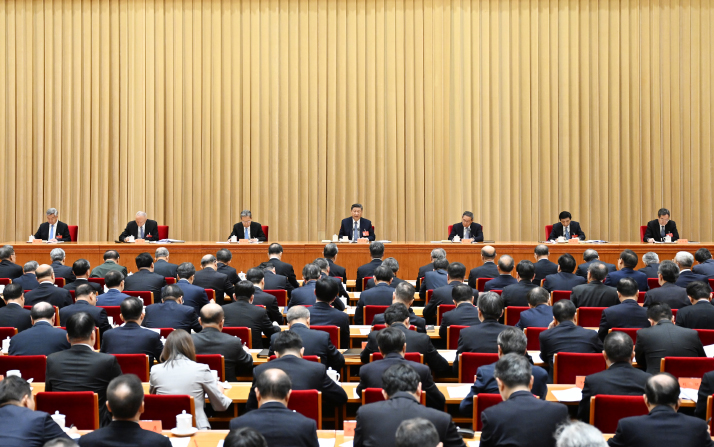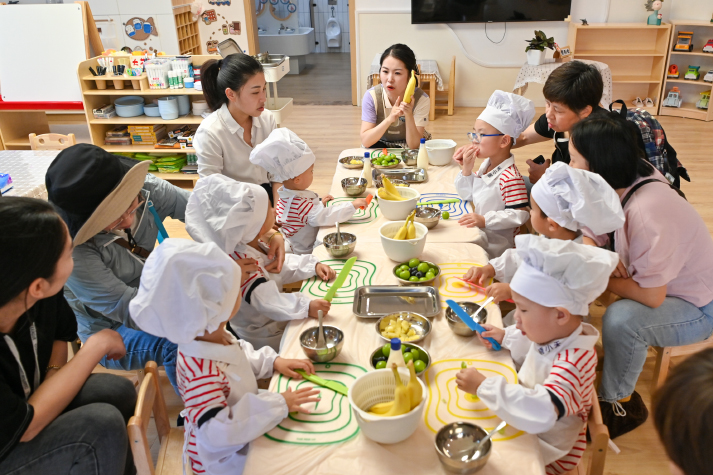| Business |
| Annual economic work conference presents roadmap for 2025 | |
| The foundation of the economy remains stable, with sufficient advantages, strong resilience and huge potential | |
|
|
 The Central Economic Work Conference convenes in Beijing on December 11-12 (XINHUA)
The year-end Central Economic Work Conference is a pivotal event in China's economic calendar, serving as a platform to analyze the nation's economic landscape, set the policy tone, and outline key priorities for the coming year. This year, it convened in Beijing on December 11-12. "China is on track to achieve its key economic and social development goals for the year, with an anticipated economic growth rate of around 5 percent," said Han Wenxiu, Executive Deputy Director of the Office of the Central Committee for Financial and Economic Affairs, elaborating on the key points of the conference at a meeting on December 14. He added that China's contribution to global economic growth is expected to approach 30 percent. Employment and prices have remained stable, a basic equilibrium in the balance of payments has been largely maintained, and the country's foreign exchange reserves have remained robust at over $3.2 trillion. Despite this, the adverse effects of changes in the external environment have intensified, and China's economy continues to face a range of difficulties and challenges. Challenges discussed at the conference include insufficient domestic demand, operational difficulties for some businesses, pressure on employment and income growth for the population, and persistent risks and uncertainties. However, according to the assessment presented at the conference, the foundation of the economy remains stable, with sufficient advantages, strong resilience and huge potential. The long-term supportive conditions and the fundamental positive trend have not changed.  Visitors enjoy the outdoor hot springs at a resort hotel in Benxi, Liaoning Province, on December 12 (XINHUA)
More proactive policies The conference outlined key adjustments to the country's macroeconomic policies, emphasizing a shift toward more proactive and impactful approaches. It called for the adoption of a "more proactive fiscal policy" and a "moderately loose monetary policy." Han said this marks a major change in both language and direction when compared to previous years. The wording regarding fiscal policy has been adjusted from "proactive" to "more proactive," implying additional efforts will follow in 2025. The deficit-to-GDP ratio was set at 3 percent for 2024, and the conference first explicitly stated the need to set a higher deficit ratio for 2025 to ensure that fiscal policies will maintain continuity and become more effective. To address the current issue of insufficient domestic demand, it is necessary to increase government spending. And it's both necessary and feasible to increase the deficit ratio, said a recent commentary by newspaper Economic Daily. From an international perspective, China's government debt ratio is much lower than that of major economies and emerging market countries. According to the International Monetary Fund, by the end of 2023, the average government debt ratio of Group of Seven countries was 123.4 percent, while that of China stood at 67.5 percent. This indicates that there remains considerable room for the Central Government to issue debts and expand the deficit. In addition, China will also increase the issuance of ultra-long special treasury bonds and local government special-purpose bonds. The conference also emphasized the need to optimize the structure of fiscal expenditures, improve the efficiency of fund usage, and place greater emphasis on enhancing people's livelihoods and stimulating consumption. The structure of fiscal expenditures should align with the stage of economic development, shifting from an investment-focused approach to one that balances investment and consumption. This marks a transition from a construction-driven fiscal policy to one that prioritizes people's livelihoods, said Yuan Haixia, Deputy Director of the Research Institute of China Chengxin Credit Rating Group. Monetary policy will shift from "prudent" to "moderately loose," with reductions in the reserve requirement ratio (RRR) and interest rates at an appropriate time, according to the conference. China's central bank, the People's Bank of China, adjusts its monetary policy in response to changes in the economic situation. Since 2011, China's monetary policy has consistently been "prudent." This adjustment is the first change in over a decade. Zeng Gang, Director of the Shanghai Institution for Finance and Development, told Xinhua News Agency that a moderately loose monetary policy helps maintain reasonable liquidity, reduces the overall financing costs in society and further expands domestic demand, unlocking the potential for consumption and investment. Xu Hongcai, Deputy Director of the Economic Policy Commission at the China Association of Policy Science, predicted that China may reduce the RRR by 1 percentage point next year, with interest rate cuts likely to be within 0.5 percentage points. Han said these policies are beneficial for enhancing counter-cyclical adjustments, better addressing the instability and uncertainty in economic operations, and providing strong policy support to achieve the annual goals and objectives. Counter-cyclical adjustment refers to the government's use of policy tools and measures to smooth out the fluctuations of the entire economic cycle, helping to better promote economic development by responding to different stages of the economic cycle.  Children engage in activities accompanied by childcare teachers and their families in the first public-funded childcare center in Nanjing, Jiangsu Province, on December 10 (XINHUA)
Top priority The conference outlined nine key tasks for the upcoming year, with "vigorously boosting consumption, improving investment efficiency and expanding domestic demand on all fronts" listed as the top priority. "In recent years, expanding domestic demand has been a top priority, and it is especially crucial in the coming year, as external demand is expected to further weaken," Xu told Beijing Review. In this context, to ensure steady economic growth, it is essential to boost internal demand. This can be achieved by focusing on both investment and consumption, he said. Xu said the conference highlighted the importance of improving investment efficiency. He stressed the need to avoid ineffective investments, such as vanity projects, and to redirect funds toward critical areas, including public welfare, hi-tech innovation and the development of strategic future industries. Additionally, investments should focus on urgent sectors such as healthcare, services for the elderly and emerging markets, he said. Government funding should play a leading and guiding role in rural revitalization infrastructure investments, particularly in guiding the application of artificial intelligence technology, and promoting the digital economy's role in upgrading and transforming traditional industries. By doing so, it will help stimulate investment demand and boost the confidence and enthusiasm of private enterprises and private capital, Xu said. In terms of consumption, since this year, policies aimed at promoting consumption, such as trade-in programs for consumer goods, have seen tangible results, leading to a continued release of consumer demand in China. According to the latest data from the Ministry of Commerce, the trade-in policy for consumer goods has driven sales of related products to exceed 1 trillion yuan ($137.3 billion). According to the conference, large-scale equipment upgrades and consumer goods trade-in programs should be promoted with greater intensity and scope next year, and a special campaign dedicated to stimulating consumption should be implemented. In addition to direct stimulus measures, boosting household income is a crucial way to promote consumption, which can be achieved by expanding employment opportunities and enhancing social security systems, Xu said. This point was included during the conference, which called for efforts to increase the incomes and alleviate the burdens of low- and middle-income groups. The conference also emphasized the importance of developing the debut economy, ice and snow economy and silver economy. The debut economy refers to a range of economic activities involving the launch of new products, new business models, new services or new technologies, as well as the opening of new flagship stores. The silver economy is based on demand created by China's aging population. Xu said, beyond traditional basic consumption, future efforts should focus on upgrading and improving consumption demand. This includes addressing needs in health and cultural domains. He highlighted the importance of innovating consumption scenarios, enhancing consumer experience and fostering the development of new consumption patterns such as digital and green consumption. Key areas of focus In addition to improving domestic demand, the conference outlined another eight tasks for 2025. It said the country should take steps to make scientific and technological innovation drive the development of new quality productive forces and build a modernized industrial system. Among many key points related to this task, "addressing rat-race irrational competition" has garnered great public attention. The rat-race competition refers to businesses engaging in zero-sum competition for a fixed pool of resources without seeking new growth points through innovation, Tian Xuan, Associate Dean and Chair Professor of Finance at Tsinghua University PBC School of Finance, told China Central Television. Shifting from a focus on inventory to generating new incremental growth requires the development of new quality productive forces and advancements in technological innovation, he said. Through innovations in technology, products and business models, companies can identify fresh profit growth points, offer better and higher-quality products, and deliver improved services. This approach provides a pathway to break free from the rat-race competition and drive progress, he added. The conference also called for giving full play to the leading role of economic system reform and ensuring that landmark reform measures are effectively implemented. Key focuses include the introduction of a law on private sector promotion, the development of guidelines for building a unified national market, and the deepening of comprehensive reforms in capital market investment and financing. It clearly emphasized the need to ensure the implementation and effectiveness of key reform measures, signaling that a series of major reforms are expected to be rolled out next year. These include reforms in the fiscal and taxation systems, financial system, state-owned enterprises, technology and innovation systems, and social security systems, Tian said. China should expand its high-standard opening up and keep foreign trade and foreign investment stable, according to the conference. Zhou Mi, a researcher at the Chinese Academy of International Trade and Economic Cooperation, told newspaper Economic Information Daily that currently, pilot programs for opening foreign-invested hospitals have already begun. The conference's call to steadily advance the opening of the service sector, expand pilot openings in areas such as telecommunications, healthcare and education, and continue to build the "Invest in China" brand signifies that the investment environment is expected to become more stable in the future. The conference also called on authorities to prevent and mitigate systemic risk in key areas. Real estate remains one of the key sectors where risk mitigation is crucial, and the impact of recent policies is starting to become evident, Liu Lin, a researcher at the Chinese Academy of Macroeconomic Research, told Xinhua. In late September, the central bank introduced a series of favorable policies for the real estate sector. According to data from the Ministry of Housing and Urban-Rural Development, the total transaction volume of newly built commercial housing and second-hand homes increased by 3.9 percent year on year in October, the first month of growth after eight consecutive months of decline. Liu said the efforts mentioned during the conference to intensify the renovation of urban villages and dilapidated housing and revitalize existing land resources and commercial and office properties reflect the policy approach of driving efforts from both the supply and demand sides. These measures are expected to sustain the current positive momentum and further translate policy benefits into market confidence and developmental gains. The conference also called for efforts to pursue coordinated progress in the new-type urbanization and all-around rural revitalization, and promote integrated urban-rural development, strengthen the implementation of regional strategies to boost regional development and ramp up the green transition in all areas of economic and social development. It called for intensified efforts to secure and improve people's wellbeing, demanding implementation of employment support plans for key sectors and industries, urban and rural communities, and micro, small and medium-sized enterprises. According to the conference, the country should formulate pro-childbirth policies, develop community-supported at-home elderly care, and expand universally beneficial elderly care services. Ensuring and improving people's livelihoods is at the heart of China's economic work, and helping everyone lead better lives is the ultimate goal, Niu Li, Deputy Director of the Department of Economic Forecasting at the State Information Center, told China Central Television. The focus begins with measures to ensure that employment remains stable and income sees steady growth. The conference clearly emphasized the need to stabilize the real estate and stock markets, and address risks in key areas to ensure that no systemic risks occur, thereby ensuring consumer confidence and encouraging spending. When the economy stabilizes, social stability follows, creating the foundation for an improved quality of life, Niu said. BR The Nine Major Tasks for 2025 Outlined at the Central Economic Work Conference Boosting consumption, improving investment efficiency and expanding domestic demand Driving the development of new quality productive forces through scientific and technological innovation and building a modernized industrial system Giving full play to the driving role of economic system reform and ensuring effective implementation of landmark reform measures Expanding high-standard opening up while keeping foreign trade and foreign investment stable Preventing and defusing risks in key areas to ensure that no systemic risks occur Pursuing coordinated progress in new-type urbanization and all-around rural revitalization and promoting integrated urban-rural development Implementing regional strategies and boosting regional development vitality Cutting carbon emissions, reducing pollution, pursuing green development and boosting economic growth, and ramping up the green transition in economic and social development Ensuring and improving the people's wellbeing, and giving the people a growing sense of fulfillment, happiness and security (Print Edition: Strategic Focus) Copyedited by G.P. Wilson Comments to zhangshsh@cicgamericas.com |
|
||||||||||||||||||||||||||||||
|